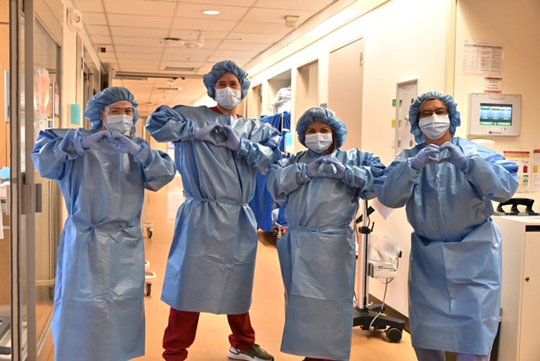
By Mary O’KEEFE
As CVW has stated in numerous articles for many weeks now, the COVID-19 pandemic has been challenging for those who have lost their loved ones, for those who have tested positive for the virus, for those who have lost their jobs and those who are on the brink of losing their business. This has been an unprecedented time and no more so than for those in the medical field.
CVW reached out to USC Verdugo Hills Hospital CEO Keith Hobbs to ask how he and his staff are holding up through these trying times, and how his hospital has prepared and continues to prepare for the days to come.
“The morale at the hospital is pretty high at this point in time,” Hobbs said. “We have developed a number of daily updates for communication to the staff so they feel like they are up-to-date with the latest information.”
They communicate via morning “huddles,” a daily 2:30 p.m. virtual meeting with Hobbs when he shares updates on what is happening at the facility, and email communications that keep staff informed of some of their biggest questions that include the supply of PPE [personal protective equipment] and what the staff should do regarding patient visitors.
“Overall the staff morale has been high,” he said. “I do want to add that a big [reason] why that is the case is because of the outpouring of support from the community.”
Hobbs shared one of the ways the community has been supportive of the staff is the development of a meal train in which community members can sign up online to supply lunch or dinner for the staff.
“It was put together by the local La Crescenta area that coordinated with local families and businesses that want to donate meals to our staff on the frontlines,” he said. “This week on Monday, Wednesday and Friday every staff member will have been fed each of those days. It’s been wonderful.” (Information about meals for ED and ICU staff via Meal Train is available at bit.ly/uscvhhmeals.)
Many hospitals have been concerned about supplies of PPE gear and ventilators, especially with an expected surge in cases that may be facing the hospital.
“On the PPE front, our hospital has [supplies] between 30 and 90 days on hand. The one item that we are running a little short on is hand wipes,” he said.
The hospital staff is looking at other avenues to acquire the cleaning wipes to wipe down countertops.
“On the ventilator front, our hospital early on acquired the number of ventilators to double [the number we had on-site] and within a week we will be able to triple the fleet of ventilators so we’ll be able to take care of any issue that may occur,” Hobbs said.
USC-VHH has had many drills in the past that focused on a variety of emergency responses, from earthquakes to fires to pandemics.
“In preparing for this pandemic we started back in December [with] running drills through our emergency department, which is where we thought the majority of our patients would come through who tested positive for the virus. Starting in December we started working on stockpiling and building up our inventory of PPEs,” Hobbs said.
But even though the staff did start planning early it is still accepting donations from the community to build up its reserves just in case it sees the volume of cases that New York and New Jersey are seeing.
“We have expanded [the drills] to the point where we’ve taken areas of the hospital and re-purposed them so that we can use them as ICUs or we can use them as a COVID nursing unit,” he added.
Hobbs explained why he felt they needed to start preparing early for this health threat.
“I think when we started seeing reports out of China and Wuhan we started looking at how we would prepare for a disaster like that. All hospitals are required to do disaster drills throughout the year and we decided to start focusing specifically on [COVID-19] in the event our local community would get hit,” Hobbs said.
No matter how much planning has been done and will continue to be done, Hobbs said that COVID-19 is a very different virus.
“I’ve been in healthcare now for about 30 years,” Hobbs said. “I have never seen [anything] like this ever, not only in my healthcare experience but in my lifetime. It is new; we are collecting data on it from experts from around the world so that when we eventually hit our surge in Southern California we had the latest treatments and the latest protocols to hopefully be able to help flatten this curve from future patients obtaining it and having poor outcomes for our current patients.”
Our conversation with USC-VHH CEO Keith Hobbs continues next week.
